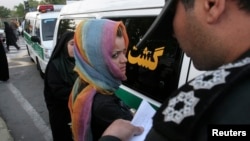Welcome back to The Farda Briefing, an RFE/RL newsletter that tracks the key issues in Iran and explains why they matter. To subscribe, click here.
I'm Hannah Kaviani, a senior broadcaster and editor at RFE/RL's Radio Farda. Here's what I've been following and what I'm watching out for in the days ahead.
The Big Issue
In a surprise move, Iran's chief prosecutor said on December 3 that the country's notorious morality police had been "closed," although he prompted confusion a day later by adding that the force "had nothing to do with the judiciary." Mohammad Jafar Montazeri also said parliament and the judiciary were "working" on reviewing the law requiring women to wear the hijab in public.
Ali Khan Mohammadi, the spokesman for the official Headquarters For Promoting Virtue and Preventing Vice, which oversees implementation of Islamic edicts, said on December 5 that the mission of the morality police was over, but that new methods would be used to enforce Iran's Islamic dress code. But the Interior Ministry, which oversees the force, has not commented.
The confusion and mixed signals have led to speculation that the authorities are considering concessions in an attempt to appease antiestablishment protesters and end the ongoing monthslong demonstrations that have raged across the country.
The rallies were triggered by the September 16 death of 22-year-old Mahsa Amini, who died days after she was arrested by the morality police for allegedly violating the hijab law. The dreaded force, also known as the Guidance Patrols, enforces the strict dress code.
Why It Matters: The apparent decision by the authorities to disband the morality police has been met with widespread skepticism. Amnesty International on December 6 said the international community should not be "deceived" by the authorities' "vague and conflicting statements." Activists have also said that it is unlikely that the authorities will scrap or radically change the hijab law. The head scarf remains one of the key pillars of the Islamic republic.
It remains unclear if the apparent dismantling of the morality police and potential reforms to the hijab law will even be enough to appease anti-regime protesters.
The protests began as a rebuke against the brutal enforcement of the mandatory head scarf. But they have snowballed into one of the biggest threats to Iran's establishment in years, with demonstrators calling for an end to clerical rule and demanding their social and political freedoms.
What's Next: Some observers say that any concessions that the authorities make to the antiestablishment demonstrators now might be too little, too late, especially after a brutal government crackdown that has killed at least 448 protesters.
A popular slogan chanted by female protesters -- "With or without hijab, we are going toward a revolution" -- appears to capture the uncompromising mood among women, who have played a prominent role in the protests. Many women appear likely to continue protesting despite efforts by the authorities to appease them.
Stories You Might Have Missed
Two Iranian women who fled to neighboring Armenia with their families have told RFE/RL's Armenian Service that they fear for their lives should they be forced to return home. The faces and voices of the two women were disguised to protect them. "I was forced to come to Armenia because of social and political problems," one of the women said. "Women [in Iran] have faced problems with [the country's] laws for more than 40 years." The two women fled Iran amid the protests and subsequent government crackdown.
An Iranian theater group, comprised of men and women without their head scarves, recently released a silent video with a message of resistance and hope. Two senior members of the group, Hamid Pourazari and Soheila Golestaneh, were detained shortly after the video was released on November 27. Playwright Naghme Samini wrote in an Instagram post that despite the detentions, "theater itself cannot be detained." Various artistic groups in Iran and Europe have paid tribute to the detained artists by recreating their silent act.
What We're Watching
Anti-regime protesters staged a three-day nationwide strike on December 5-7. In posts on social media, demonstrators urged businesses to close and called on residents to stop using banks. Videos uploaded on social media appeared to show that some shops were closed in cities across the country. A heavy security presence was reported in many of those cities, including Tehran.
During the strike, university students staged sit-ins in various cities. Truck drivers and factory workers, meanwhile, refused to work.
Why It Matters: This was the second three-day strike announced since the protests erupted in September. The level of participation during the latest strike appears to be higher. The strikes have added pressure on the authorities in Iran, where the economy has been crippled by years of U.S. sanctions and government mismanagement.
Larger and more regular strikes could have significant ramifications, especially if workers in Iran's key energy sector participate. Major strikes by public employees preceded the Islamic Revolution in 1979, bringing large parts of the economy to a halt.
Avril Haines, the head of U.S. intelligence, said on December 3 that the Iranian authorities do not see the protests as "an imminent threat to their stability." But she added that the government's deadly response to the protests combined with other factors, including the bleak economic situation in Iran, "will lead to a greater risk of unrest and instability over time."
That's all from me for now. Don't forget to send me any questions, comments, or tips that you have.
Until next time,
Hannah Kaviani
If you enjoyed this briefing and don't want to miss the next edition, subscribe here. It will be sent to your inbox every Wednesday.






